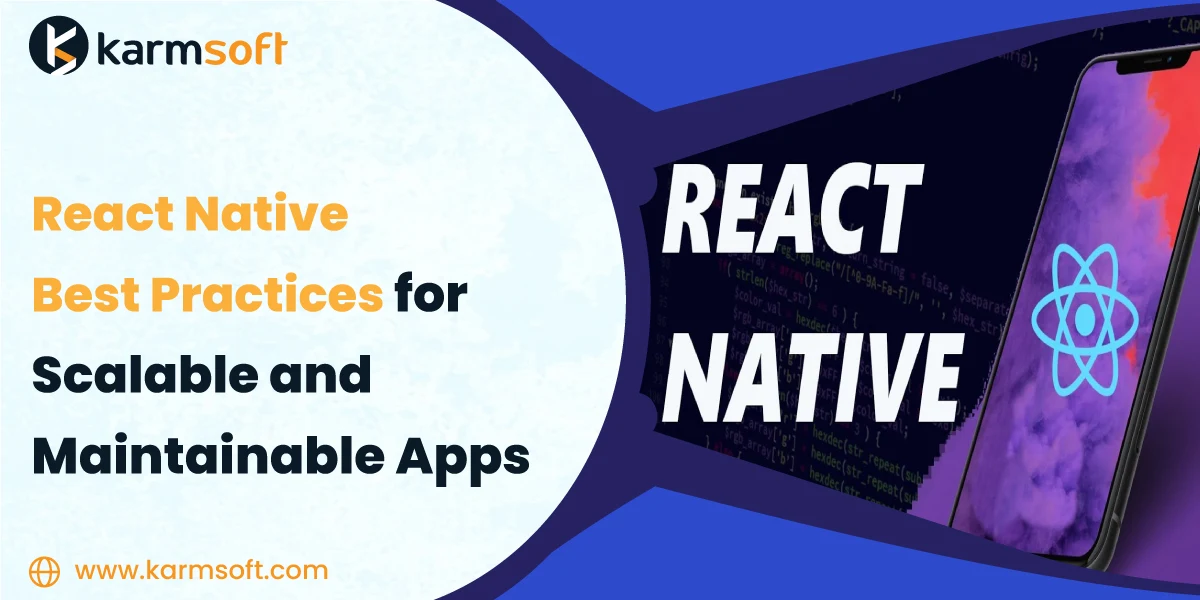Blog
React Native Best Practices for Scalable and Maintainable Apps
July 25, 2025Hardik Panchal

Gone were the days when we only thought of building mobile applications, no matter what features they consisted of. Now, the rapidly evolving digital verse is requiring the application to be extremely scalable and maintainable, as these two aspects are the major demands of the users. No matter if you are creating a startup product or want to scale your enterprise solution, unstructured or poor architecture can curb its performance values.
This is why many developers are considering React Native to be their foremost choice. This efficient framework can develop cross-platform apps with the integration of a single codebase. The development aspect with React Native is going to adopt a growth rate of 16.7% in the near future. So, this trend is going to fuel its power due to the framework's speed and flexibility. Its valuable ecosystem and active community make it a top pick for businesses, and they desire the help of React Native app development services.
In this blog, we will further highlight the React Native best practices that help applications remain scalable and maintainable over time. Check out the important steps below.
Also Read: BestTop 7 Features That Make Node.js the First Choice for Business Leaders
If you have a strong project structure, your React Native app can be highly scalable and can be maintained easily. This process reflects consistency and eases the onboarding process for new developers.
● You can ask the professionals to separate business logic, UI components, API services, etc. These React Native styling best practices can make your code easier to test and debug.
● Make sure to use a feature-first approach. Each of the features should have its own folder with all the necessary files inside.
● If your files remain small and focused, it will be easier for the developers to scan and understand the code efficiently. They can simplify the unit testing mechanism through the isolation of the logic.
● With the modular feature of files, multiple developers can work on it in a collaborative manner. This way, you can give rise to team productivity and restrict the overlapping of codes.
● This is one of the reliable React Native best practices in 2025, as it offers clear and predictable names for the files and components. This helps the new developers to grasp the codebase effectively.
● With consistency, you can improve compatible factors with IDE features, code formatters, etc. Through this, your whole development process can be more efficient.
Effective state management is crucial for keeping your application predictable and responsive. Misinterpreted state can make your application deliver poor performance.
● Make sure to curb the usage of global state libraries such as Redux and Zustand for UI-centric data. You can use useReducer or useState when you need it for local aspects.
● Place the state in the nearest ancestor to keep the logic manageable. Avoid unnecessary re-renders and simplify the debugging process.
● In one of the React Native latest best practices in 2025, you can isolate the logic and side effects in the services. This way, you can test them independently without depending on the UI components.
● UI components should mainly prioritize rendering. Keeping aside the business logic can keep the component simple and easy to maintain.
With a scalable styling approach, your application will look consistent and can be easily updated when it grows in the future.
● No matter if you are choosing styled-components or the StyleSheet API, rely on one method and be consistent with it. Through this, you can avoid confusion.
● Use consistent themes, styles, and design. This encourages a unified UI and reduces the chances of duplicate code.
● With the usage of a design system, you can easily standardize the UI elements, making the application visually appealing.
● Themes give you access to switch between different styles and adopt different branding changes whenever you need it for your users.
● Make sure to keep the styles in the same folders along with their related components. Through this, it can be easier for you to locate them with no hassle.
● Reuse shared styles to decrease redundancy and adopt consistency for the application instead of going for styling duplication.
If you offer a clean navigation setup to your targeted audiences, the setup can improve your app performance and ensure a viable user experience.
● Keep your navigation facilities in different and dedicated files. Saving this separate from the screen components can make your code easier to manage.
● With the effectiveness of centralized navigation logic, it is easier to trace the routes and implement changes without disturbing other integral components.
● This is one of the best practices for React Native users, as defining all routes in one place gives you access to quickly update features and get a clear overview of the app's performance.
● With the efficiency of centralization, you can maintain uniformity of the app, like transitions, authentication checks, headers, and much more.
Performance issues in an app can make your users abandon you quickly. This aspect is mainly seen on lower-end devices.
● Use SectionList or FlatList for a huge database and integrate lazy loading to curb the usage of unnecessary rendering.
● Less rendering and effective screen loading can help you maintain the high frame rates and offer a seamless user experience.
● To manage your media, use lazy-load content, compress images, and cache assets to minimize the load times.
● Precisely clean the timers and listeners to avoid memory leaks. You can use different tools to avoid baseless component re-rendering.
● You can use tools like React DevTools and Flipper to monitor the performance of the app. This way, you can review the mistakes during the development phase only.
● This is one of the React Native app's best practices, where you will regularly profile and fine-tune the app's behaviour. This aspect can help your app to adopt a consistent and smoother experience.
Reliable and clean code is necessary for long-term maintenance of the application. Strong steps can help you catch the problems effectively and keep your team coordinated.
● With the usage of PropTypes and TypeScript, you can detect type mismatches during the development phase. Moreover, it can reduce the chances of bugs during production.
● With a strong typing strategy, you can adopt smarter auto-completion and documentation directly in your IDE.
● There are premier tools like ESLint and Prettier that allow you to write code in a precise manner. This way, your team can assess and work together on a project.
● With the inclusion of automated formatting, you can catch the styling issues at an early stage. This allows reviewers to focus on the functionality of the app.
● Proper testing allows all the components and business logic of your app to function as per your expectations. This will also reduce the bugs and broken features.
● With reliable test runs, you can verify the anomalies in the app during the development phase. So, you can prevent your app from unexpected failures.
Managing the app's dependencies can help you prevent technical debts and keep your project maintainable and safe.
● With frequent updates and effective elements, you can safeguard the functionalities of your application.
● Outdated packages can put your app at risk of bugs and vulnerabilities. Routine updates and features can keep your app protected. This is one of the efficient React Native best practices you can rely on.
● Lock your files and ensure the same package version is installed for your app consistently to avoid any mistakes.
● Version control, along with lock files, ensures a precise development phase and helps the team prevent bugs and inconsistencies.
Also Read: Top 10 React Native Development Companies in India
Automation helps the development process to be quicker without compromising on quality. This also helps the team to robustly verify the app even if the codebase grows.
● Make sure to use CI tools that help in running the tests automatically, and check the lint and validate the format as per your preferences.
● CI/CD pipeline ensures the code is not ruining the existing elements and features. It allows your team to scale the development process as per your wish.
● With the usage of automation tools, you can nullify the manual efforts of the developers and ensure that the development process is done efficiently.
● It keeps the app consistent as automation reduces the chances of human errors and ensures the app is performing well across all environments.
The above blog highlights the integral nature of React Native best practices, which include performance optimization, smart structuring, and code quality efforts. If you value investing in these practices, you can save time and enrich your app for future performance. With the development of your team, your approaches should also be enhanced.
If you want to rely on expert guidance, take the help of an expert React Native application development company in India, which can help you implement these practices effectively

About the Author
Hardik Panchal, CTO, Scrum Master, and Software Architect at Karmsoft, leads the charge in creating innovative web and mobile applications. His technical expertise and commitment to client satisfaction drive Karmsoft’s success. Hardik is passionate about turning ideas into practical digital solutions that help businesses grow.